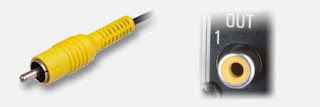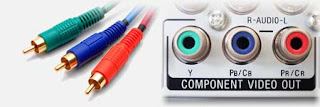Composite Video Terminal
COMPOSITE VIDEO
These video terminals are the old standard "A/V" jacks you're probably familiar with. A composite video cable delivers both chrominance (color) and luminance (light/dark or grayscale) information along the same cable. While composite video is far inferior to Component Video, it's still capable of producing a good picture, and may be your only option for VCRs and some cable boxes. Be sure to use a high-quality composite video cable for best results.
S-Video Terminal
S-VIDEO
S-Video uses a 4-pin rounded plug to separate the chrominance and luminance signal, which theoretically should improve picture quality over the standard composite video "A/V" connection. In practice however, we've found that most of today's HD televisions perform just as well, or even better, with the composite connection: the video processing circuits in the TV will do a fine job of separating the information once it reaches the monitor.
Component Video
Terminal
COMPONENT VIDEO
The best of the analog video connections, component video terminals are found on almost any HD TV you'll be considering, and can be used for progressive-scan DVD, HDTV, and your higher-end cable and satellite boxes. One important note is about the bandwidth of the component video terminal: if you want to use component inputs for HDTV, look for component inputs called "high-bandwidth" or "HDTV component video" to ensure the terminal can handle the extra information passed through an HDTV signal.
DVI Interface
DVI (DIGITAL VISUAL INTERFACE)
DVI is a multi-pin plug used to transfer video information in an all-digital format. Because the signal undergoes less digital-to-analog conversion, DVI should result in a sharper picture with less conversion artifacts. Most DVI outputs provided by Home Theatre gear will be of the DVI-D type, which only carries digital signals, and usually supports the HDCP (High Bandwidth Digital Content Protection) standard of copy protection used by many HDTV providers.
DVI (DIGITAL VISUAL INTERFACE)
Many PC video cards use DVI outputs as well, and you may find HD TVs with DVI-I terminals, which support both digital and analog signals. If you see a DVI-I terminal on a TV which does not support HDCP, it's most likely intended for PC use.
HDMI Interface
HDMI (HIGH-DEFINITION MULTIMEDIA INTERFACE)
HDMI (HIGH-DEFINITION MULTIMEDIA INTERFACE)
To take advantage of the latest and greatest, you'll want an HD TV with an HDMI input - or the option of adding an HDMI terminal board to your TV. With a bandwidth of up to 10 Gbps, the HDMI standard allows for transmission of high-quality digital video (up to 1080p) along with up to 8 discrete channels of audio, all on the same cable. Found on the latest HDTV set-top boxes, Blu-ray players and a growing number of DVD players - many with HDTV-quality up-conversion, HDMI has proven more than a home theatre fad, and should be around for years to come. Backwards compatibility with the older DVI standard means you can use an adapter cable ("DVI to HDMI cable") to use DVI output devices with your HDMI-enabled HD television.
(Images courtesy Tweaking4ALL)
(Images courtesy Tweaking4ALL)
Looking for the best audio connection? Then visit our Best Audio Connection page.






No comments:
Post a Comment